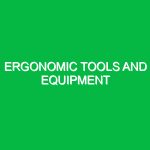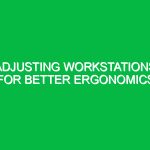In today’s fast-paced workplace, the importance of selecting ergonomic tools to reduce strain cannot be overstated. Ergonomics is the science of designing and arranging things people use so that the people and things interact most efficiently and safely. This principle is particularly vital in the Health, Safety, and Environment (HSE) domain, where the right tools can significantly decrease the risk of injury and enhance productivity. In this article, we will dive into the nuances of selecting ergonomic tools, explore associated hazards, best practices, and relevant regulations, all while emphasizing the need for a thoughtful approach to ergonomics.
Understanding Ergonomics in the Workplace
The concept of ergonomics extends beyond mere comfort; it encompasses the physical, cognitive, and organizational aspects of work. Selecting ergonomic tools to reduce strain is about creating an environment where employees can perform their tasks efficiently without undue stress on their bodies. Strains and musculoskeletal disorders (MSDs) are common in workplaces lacking ergonomic considerations. To put it in perspective, according to the Bureau of Labor Statistics, musculoskeletal disorders accounted for 30% of all workplace injuries and illnesses in recent years. This statistic highlights the critical need for organizations to prioritize ergonomic solutions.
Identifying Hazards and Risks
When it comes to selecting ergonomic tools, understanding potential hazards is a crucial step. Ergonomic hazards arise when the physical demands of a job do not match the capabilities of the worker. Here are some common ergonomic risks:
1. Repetitive Motions
Tasks that require repetitive motions can lead to fatigue and injury over time. For instance, assembly line workers often perform the same motion hundreds of times a day, which can strain muscles and tendons. A personal anecdote from a manufacturing facility illustrates this risk well: employees reported experiencing discomfort in their wrists and shoulders after prolonged use of non-ergonomic tools. This discomfort was alleviated by switching to tools designed with ergonomics in mind, which reduced the strain on their bodies significantly.
2. Awkward Postures
Working in awkward positions can lead to musculoskeletal issues. For instance, a data entry clerk who spends hours hunched over a keyboard may develop chronic back pain. Organizations can mitigate this risk by providing adjustable desks and chairs that encourage proper posture. A case study from an office setting demonstrated that employees using adjustable furniture reported a 40% reduction in reported back pain after just three months.
3. Forceful Exertions
Jobs that require heavy lifting or forceful exertions can lead to acute injuries or chronic conditions. For example, warehouse workers lifting heavy boxes without proper tools can suffer from back injuries. Implementing tools like forklifts or pallet jacks can significantly reduce this risk.
4. Static Postures
Remaining in a static posture for extended periods can cause discomfort and strain. For instance, a cashier standing for hours may experience leg and back pain. Solutions like anti-fatigue mats or sit-stand workstations can help alleviate discomfort.
Best Practices for Selecting Ergonomic Tools
With a clear understanding of potential hazards, the next step is to implement best practices when selecting ergonomic tools. Here’s how to approach this task effectively:
1. Assess the Work Environment
Begin by evaluating the specific tasks employees perform and the tools they currently use. A thorough assessment can identify the most pressing ergonomic risks. Engaging employees in this process allows for firsthand insights into their challenges and preferences, which can lead to better tool selection.
2. Involve Employees in the Selection Process
Involving employees in selecting ergonomic tools fosters a sense of ownership. For instance, an organization that included its staff in the selection of new office chairs found that employees were more satisfied and used the tools effectively. This participatory approach can also highlight needs that management might overlook.
3. Prioritize Adjustable and Customizable Tools
Select tools that can be adjusted to fit individual user needs. For example, adjustable chairs and desks can accommodate various body types and preferences. This adaptability is critical in a diverse workforce where one-size-fits-all solutions often fall short.
4. Educate Employees on Proper Tool Usage
Providing training on how to use ergonomic tools effectively is essential. Employees should understand how to adjust their workstations and tools to suit their needs. A case in point: a tech company that implemented training sessions reported a 25% decrease in ergonomic-related injuries after employees learned to use their equipment correctly.
5. Regularly Review and Update Ergonomic Tools
Ergonomics is not a one-time effort but an ongoing process. Regularly review tools and practices to ensure they meet the evolving needs of the workforce. Additionally, staying informed about new ergonomic tools and technologies can lead to improved workplace health. For instance, advancements in wearable technology can provide real-time feedback on posture and movement, encouraging better habits.
Safety Precautions to Consider
While selecting ergonomic tools is crucial, implementing safety precautions ensures further protection against potential hazards. Here are some actionable safety measures:
1. Implement Stretch Breaks
Encouraging employees to take regular stretch breaks can help mitigate the risks associated with static or repetitive tasks. Simple stretches can relieve tension in muscles and improve circulation, ultimately reducing the risk of injury.
2. Monitor Workloads
Excessive workloads can lead to fatigue and strain, making it crucial to monitor the demands placed on employees. Ensure that workloads are manageable, and promote a culture that values breaks and rest periods.
3. Encourage Reporting of Discomfort
Establish an open line of communication where employees can report discomfort or pain without fear of repercussions. Early reporting can lead to timely interventions, such as tool adjustments or ergonomic evaluations. For example, a construction firm that encouraged reporting injuries saw a decrease in severe incidents by 30% over two years.
Regulations and Standards in Ergonomics
Several regulations and standards govern the selection of ergonomic tools and practices. Understanding these can help organizations stay compliant and ensure a safe working environment:
1. Occupational Safety and Health Administration (OSHA)
OSHA provides guidelines regarding workplace safety and ergonomics. While OSHA does not have a specific standard for ergonomics, it advocates for practices that minimize ergonomic risks and emphasizes the employer’s responsibility to provide a safe workplace.
2. American National Standards Institute (ANSI)
ANSI has developed standards that guide the design of ergonomic tools and equipment. Following these standards can help ensure that tools are safe and effective for various users.
3. National Institute for Occupational Safety and Health (NIOSH)
NIOSH conducts research and makes recommendations for the prevention of work-related injuries. Their resources can be invaluable for organizations looking to enhance their ergonomic practices.
Conclusion
Selecting ergonomic tools to reduce strain is a vital component of promoting health and safety in the workplace. By understanding the risks associated with ergonomic hazards and implementing best practices, organizations can create an environment that supports employee well-being and productivity. Adopting a proactive approach to ergonomics not only aligns with regulatory standards but also fosters a culture of safety and awareness. In the long run, the investment in ergonomic tools pays dividends in decreased injuries, increased employee morale, and improved overall workplace efficiency.


